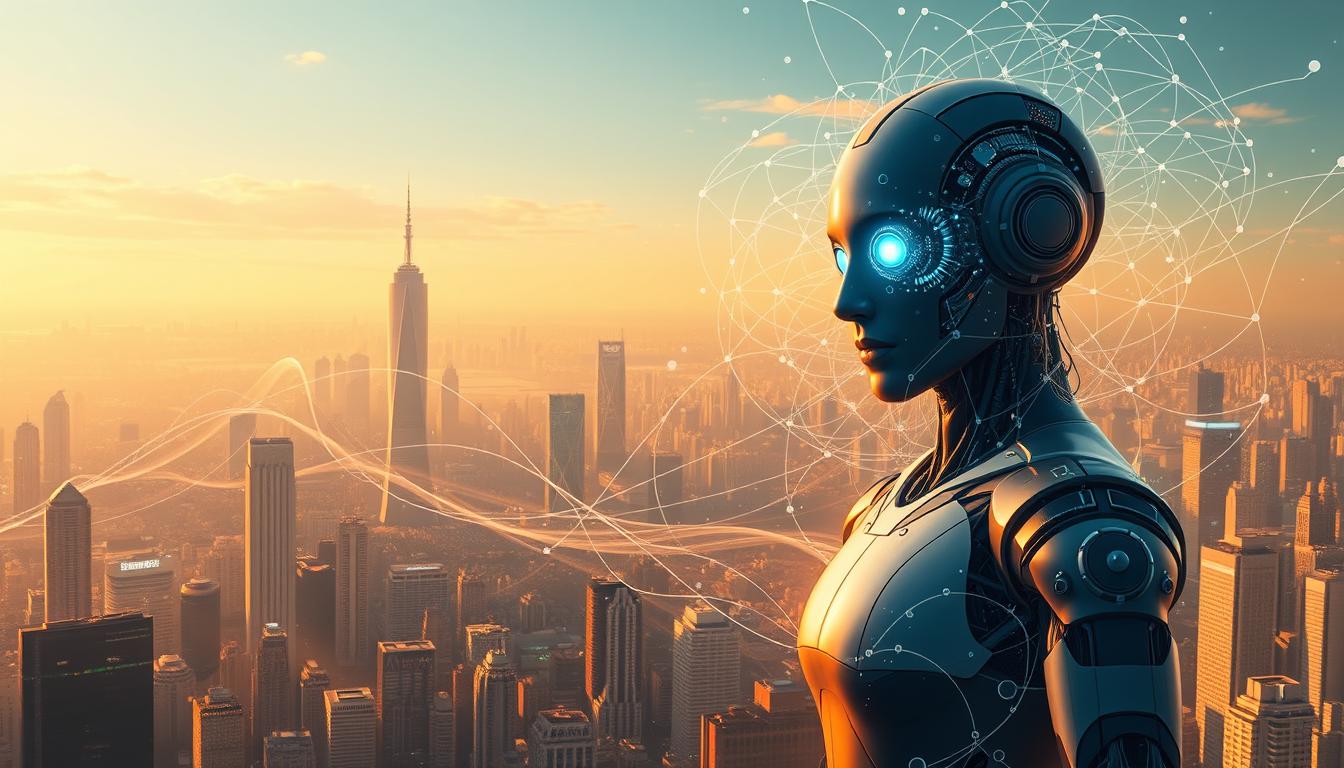
The advent of Generative AI is transforming the technological landscape, enabling machines to create and innovate in ways previously unimaginable. This cutting-edge technology has the potential to revolutionize various industries, from art and entertainment to healthcare and finance.
By harnessing the power of Artificial Intelligence, businesses and organizations can now automate complex tasks, improve decision-making, and drive innovation. As AI continues to evolve, we can expect to see significant advancements in areas such as natural language processing, computer vision, and predictive analytics.
Key Takeaways
- The rise of Generative AI is revolutionizing industries and transforming the future.
- AI-powered automation is improving efficiency and driving innovation.
- Businesses can leverage AI to enhance decision-making and gain a competitive edge.
- The future of AI holds significant promise for advancements in various fields.
- As AI continues to evolve, we can expect to see new applications and opportunities emerge.
The Dawn of a New Technological Era
The dawn of a new technological era is being driven by the rapid acceleration of AI development. This swift progress is transforming various industries and revolutionizing the way we live and work.
The Rapid Acceleration of AI Development
The development of AI is happening at an unprecedented rate, with significant advancements being made in areas such as machine learning and natural language processing. Key factors contributing to this acceleration include:
- Increased computing power
- Availability of large datasets
- Advancements in algorithms
Key Milestones Achieved in 2023
In 2023, several key milestones were achieved in AI development, including:
- The release of more sophisticated language models
- Advancements in text-to-image generation
- Increased adoption of AI in industries such as healthcare and finance
Understanding Generative AI and Its Transformative Power
At the heart of Generative AI lies a complex interplay of neural networks and deep learning algorithms. This synergy enables Generative AI to process and generate human-like data, revolutionizing various industries.
Core Technical Foundations
The effectiveness of Generative AI is rooted in its technical architecture. Key components include:
- Advanced neural networks that mimic human brain functions
- Deep learning techniques that allow for complex data processing
- Large datasets required for training these models
Neural Networks and Deep Learning
Neural networks are the backbone of Generative AI, consisting of layers of interconnected nodes (neurons) that process inputs. Deep learning takes this a step further by using multiple layers to analyze data in a more abstract and complex manner. This enables the AI to learn and generate sophisticated patterns.
Training Data Requirements
The quality and quantity of training data significantly impact the performance of Generative AI models. These models require vast amounts of data to learn patterns and generate realistic outputs. The data must be diverse and representative of the task the AI is intended to perform.
How Generative Models Differ from Traditional AI
Unlike traditional AI models that are primarily predictive or discriminative, Generative AI models are designed to generate new content. They create data that is similar in structure to the training data, making them highly useful for applications such as content creation, data augmentation, and more.
The transformative power of Generative AI is not just in its technical capabilities but also in its potential to revolutionize industries by automating creative tasks, enhancing decision-making, and unlocking new possibilities.
Recent Breakthroughs Reshaping Industries
The rapid advancements in Generative AI are transforming industries at an unprecedented rate. This transformation is driven by several key breakthroughs that have significantly impacted various sectors.
Text-to-Image Generation Advancements
One of the most notable advancements is in text-to-image generation. Models like DALL-E and Stable Diffusion have revolutionized the field, enabling the creation of highly realistic images from textual descriptions. This technology has far-reaching implications for industries such as advertising, media, and entertainment.
Large Language Models Evolution
Large Language Models (LLMs) have also seen significant evolution. Models like GPT-4 have improved language understanding and generation capabilities, making them invaluable for applications in customer service, content creation, and language translation.
Multimodal AI Systems
The development of multimodal AI systems is another critical breakthrough. These systems can process and generate multiple types of data, such as text, images, and audio, simultaneously. This capability is opening new avenues in fields like education, healthcare, and multimedia production.
These breakthroughs are not only enhancing existing processes but also creating new opportunities for innovation and growth across various industries.
Generative AI Applications Transforming Business
The advent of Generative AI is transforming the way businesses operate and innovate. By leveraging advanced algorithms and vast datasets, companies across various sectors are discovering new ways to drive efficiency, creativity, and growth.
Healthcare and Pharmaceutical Research
In healthcare, Generative AI is being used to accelerate drug discovery and personalize treatment plans. AI models can generate molecular structures with desired properties, significantly reducing the time and cost associated with bringing new drugs to market.
Creative Industries and Content Creation
The creative industries are also benefiting from Generative AI. AI-powered tools are being used to generate high-quality content, such as images, videos, and music, allowing creators to focus on higher-level creative decisions.

Financial Services and Risk Assessment
In financial services, Generative AI is enhancing risk assessment and management. AI models can generate scenarios to stress test financial portfolios, helping institutions prepare for potential market fluctuations.
Manufacturing and Supply Chain Optimization
Generative AI is also optimizing manufacturing and supply chain operations. AI can generate optimized production schedules and supply chain configurations, reducing costs and improving efficiency.
| Industry | Generative AI Application | Benefit |
|---|---|---|
| Healthcare | Drug Discovery | Accelerated development of new treatments |
| Creative Industries | Content Generation | Enhanced creativity and productivity |
| Financial Services | Risk Assessment | Improved risk management |
| Manufacturing | Supply Chain Optimization | Reduced costs and improved efficiency |
As Generative AI continues to evolve, its applications across these industries are expected to grow, driving further innovation and transformation.
The Rise of Generative AI in India’s Tech Landscape
The rise of Generative AI in India is marking a new era in technological innovation. As the country continues to solidify its position as a global tech hub, the adoption of Generative AI is playing a crucial role in driving this growth.
Adoption Rates Across Indian Industries
Generative AI is being increasingly adopted across various Indian industries, transforming the way businesses operate. Sectors such as healthcare, finance, and manufacturing are leveraging AI to enhance efficiency, reduce costs, and improve customer experiences. For instance, in healthcare, AI is being used to develop personalized treatment plans and predict patient outcomes.
“The integration of Generative AI in our operations has enabled us to streamline processes and drive innovation,” says a leading Indian healthcare executive.
Bangalore’s AI Startup Ecosystem
Bangalore has emerged as a thriving hub for AI startups, with numerous companies focusing on Generative AI. The city’s ecosystem is supported by a robust infrastructure, availability of skilled talent, and a conducive business environment. Startups such as Scale AI and Nuro are making significant strides in AI research and development.
Government Initiatives Supporting AI Development
The Indian government is actively promoting AI development through various initiatives. Programs such as Digital India and AI Mission are aimed at fostering AI research, education, and adoption.
Digital India and AI Mission
The Digital India initiative is focused on creating a digitally empowered society, while the AI Mission is geared towards developing a comprehensive AI ecosystem. These programs are expected to drive significant investments in AI research and infrastructure.
Educational Programs and Research Funding
The government is also supporting educational programs and research funding to develop a skilled AI workforce. Institutions such as the Indian Institute of Technology (IIT) and Indian Institute of Science (IISc) are receiving funding to conduct cutting-edge AI research.
As India continues to embrace Generative AI, the country’s tech landscape is poised for significant transformation. With the combined efforts of the government, industry, and academia, India is well-positioned to become a global leader in AI innovation.
Economic Impact and Workforce Transformation
As Generative AI continues to evolve, its effects on the economy and workforce transformation are becoming increasingly apparent. The integration of AI technologies is not only enhancing productivity but also reshaping the job market.
Job Creation in New AI-Driven Sectors
The emergence of Generative AI is leading to the creation of new job opportunities in sectors that were previously non-existent or underdeveloped. Roles such as AI trainer, AI ethicist, and AI data analyst are becoming increasingly prominent. According to recent reports, the AI industry is expected to create millions of new jobs globally in the coming years.
Skill Gaps and Reskilling Challenges
Despite the creation of new job opportunities, there is a growing concern about the skill gaps that exist in the workforce. As AI technologies become more pervasive, there is a pressing need for workers to acquire new skills to remain relevant. This has led to a surge in demand for reskilling programs and AI-focused education.
Investment Trends in Indian AI Companies
India is witnessing a significant surge in investments in AI companies, driven by the government’s initiatives to promote AI development. The trend indicates a growing confidence in the potential of AI to drive economic growth and transformation.

The AI investment landscape in India is becoming increasingly vibrant, with both domestic and international investors showing keen interest. This investment is expected to fuel further innovation and adoption of AI technologies across various sectors.
Ethical Considerations and Societal Challenges
With the growing influence of Generative AI, ethical considerations and societal challenges have become increasingly pertinent. As AI technologies advance, they bring with them a host of issues that need to be addressed to ensure their safe and beneficial integration into society.
Bias and Fairness in AI Systems
One of the significant ethical challenges is ensuring bias and fairness in AI systems. AI models can perpetuate and even amplify existing biases if they are trained on biased data. This can lead to unfair outcomes in areas such as hiring, law enforcement, and financial services.
Privacy Concerns and Data Protection
Privacy concerns are another critical issue. Generative AI often requires vast amounts of data, including sensitive personal information, to function effectively. Ensuring that this data is protected and used responsibly is paramount.
Intellectual Property Rights in AI-Generated Content
The rise of AI-generated content raises questions about intellectual property rights. Who owns the content generated by AI? The answer to this question is still evolving and will have significant implications for creators and industries reliant on intellectual property.
Misinformation and Deepfake Threats
Generative AI also poses the risk of misinformation and deepfake threats. The ability to create realistic images, videos, and audio can be used to spread false information or manipulate public opinion.
| Ethical Challenge | Description | Potential Impact |
|---|---|---|
| Bias in AI | AI systems perpetuating existing biases | Unfair outcomes in hiring, law enforcement, etc. |
| Privacy Concerns | Misuse of personal data for AI training | Compromised personal privacy |
| Intellectual Property Issues | Ownership of AI-generated content | Legal and financial implications for creators |
| Misinformation and Deepfakes | Spread of false information through AI-generated media | Manipulation of public opinion and erosion of trust |
Regulatory Frameworks Evolving Globally and in India
Regulatory bodies worldwide are grappling with the need to govern generative AI, balancing innovation with societal protection. As generative AI technologies become more pervasive, the need for effective regulatory frameworks has become increasingly urgent.
International Governance Approaches
Globally, various approaches are being adopted to regulate AI. The European Union has been at the forefront with its proposed AI Act, which aims to establish a comprehensive framework for AI governance. Similarly, the United States has issued guidelines and executive orders to guide the development and deployment of AI technologies.
India’s Emerging AI Regulations
In India, the government has taken significant steps towards creating a regulatory framework for AI. The Ministry of Electronics and Information Technology has released guidelines and frameworks aimed at promoting the responsible development of AI. India’s approach focuses on fostering innovation while ensuring that AI systems are transparent, fair, and secure.
Industry Self-Regulation Initiatives
Alongside government regulations, industry self-regulation plays a crucial role in shaping the future of generative AI. Tech companies and industry consortia are developing their own guidelines and best practices for AI development and deployment. These initiatives complement government regulations and help ensure that AI technologies are developed responsibly.
The evolution of regulatory frameworks for generative AI is a complex and ongoing process. As AI technologies continue to advance, it is likely that regulatory approaches will also continue to adapt, striving to balance the need for innovation with the protection of societal interests.
Expert Insights on the Future of Generative AI
Expert insights are shedding light on the potential future of Generative AI, highlighting both opportunities and challenges. As this technology continues to evolve, various stakeholders are sharing their perspectives on its trajectory.
Perspectives from Indian Tech Leaders
Indian tech leaders are optimistic about the future of Generative AI, citing its potential to drive innovation and economic growth. They emphasize the need for continued investment in AI research and development, as well as the importance of building a skilled workforce.
According to a recent survey, top Indian tech companies are planning to increase their AI investments by 30% in the next two years. This growth is expected to be driven by advancements in areas such as natural language processing and computer vision.
Global Research Community Predictions
The global research community is predicting significant advancements in Generative AI, particularly in areas such as multimodal learning and explainability. Researchers are working on developing more sophisticated models that can learn from multiple data sources and provide transparent decision-making processes.
Academic and Industry Collaborations
Collaborations between academia and industry are playing a crucial role in shaping the future of Generative AI. These partnerships are driving innovation, facilitating knowledge transfer, and enabling the development of practical applications.
| Collaboration Type | Benefits | Examples |
|---|---|---|
| Research Partnerships | Advancements in AI technology, joint research publications | Google-MIT AI Research Lab |
| Knowledge Transfer | Exchange of expertise, talent development | Stanford-Industry AI Forums |
| Product Development | Practical AI applications, faster time-to-market | Microsoft-University AI Collaborations |
As Generative AI continues to evolve, these collaborations will be essential in driving its future development and ensuring its safe and beneficial deployment.
Public Adoption and Cultural Impact in India
Generative AI is making significant inroads in India, influencing both public adoption and cultural narratives. As AI technologies become more pervasive, understanding their impact on Indian society is crucial.
Consumer Attitudes Toward AI Tools
Indian consumers are increasingly embracing AI-driven tools, with a growing acceptance of AI in daily life. AI-powered virtual assistants and personalized recommendation systems are becoming commonplace.
| AI Tool | Consumer Adoption Rate | Cultural Impact |
|---|---|---|
| Virtual Assistants | 70% | Changing interaction norms |
| Personalized Recommendations | 85% | Influencing consumer behavior |
| AI-generated Content | 60% | Redefining creative industries |
Digital Divide Concerns in Rural Areas
Despite the growing adoption of AI, concerns about the digital divide in rural India persist. Access to AI technologies remains limited in rural areas, potentially exacerbating existing socio-economic disparities.

Cultural Integration of AI Technologies
AI is being culturally integrated into various aspects of Indian life, from entertainment to education. AI-generated content is becoming increasingly popular, reflecting a blend of technology and traditional cultural narratives.
The cultural impact of AI in India is multifaceted, influencing how people interact with technology and with each other. As AI continues to evolve, its integration into Indian culture is likely to deepen, presenting both opportunities and challenges.
The Competitive Landscape: Leaders and Innovators
As Generative AI continues to transform industries, the competitive landscape in India is becoming increasingly dynamic. This shift is driven by the presence of global tech giants, the rise of innovative Indian startups, and the contributions of academic institutions.
Global Tech Giants’ Presence in India
Global tech giants are making significant inroads into India’s AI market. Companies like Google and Microsoft are investing heavily in AI research and development, establishing their presence through various initiatives and partnerships. For instance, Google’s AI research center in Bangalore is a testament to the country’s growing importance in the global AI landscape.
Indian Startups Disrupting the AI Space
Indian startups are also playing a crucial role in shaping the AI competitive landscape. Startups like Nervana Systems and Saama Technologies are leveraging AI to innovate and disrupt traditional industries. These startups are not only creating new opportunities but also challenging established players, thereby fostering a competitive environment.
Academic Institutions Driving Research
Academic institutions are the backbone of AI research in India. The Indian Institutes of Technology (IITs) are at the forefront, with dedicated AI research centers. For example, IIT Bombay and IIT Delhi are conducting cutting-edge research in AI and collaborating with industry partners to translate their findings into practical applications.
IITs and Their AI Research Centers
IITs have established specialized research centers focused on AI. These centers are equipped with state-of-the-art infrastructure and are staffed by renowned faculty. They are instrumental in advancing AI research and developing talent.
Private-Public Research Partnerships
The collaboration between private companies and public institutions is a key driver of AI innovation in India. These partnerships facilitate the exchange of knowledge, resources, and expertise, leading to the development of more sophisticated AI solutions.
In conclusion, the competitive landscape of Generative AI in India is characterized by the interplay between global tech giants, innovative startups, and academic institutions. This dynamic environment is expected to drive further innovation and growth in the AI sector.
Conclusion: Navigating the Generative AI Future
As we navigate the rapidly evolving landscape of Generative AI, it’s clear that this technology will continue to revolutionize industries and transform the way we live and work. The future of Generative AI holds much promise, with potential breakthroughs in areas such as healthcare, finance, and education.
To harness the potential of Generative AI, it’s essential to prioritize responsible development and deployment. This includes addressing concerns around bias, privacy, and intellectual property, as well as investing in education and retraining programs to support workers who may be displaced by automation.
As India continues to emerge as a hub for AI innovation, collaboration between industry leaders, policymakers, and researchers will be crucial in shaping the future of Generative AI. By working together, we can ensure that the benefits of this technology are realized while minimizing its risks.
The journey ahead will require careful navigation, but with the right approach, we can unlock the full potential of Generative AI and create a brighter future for all.




